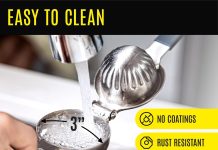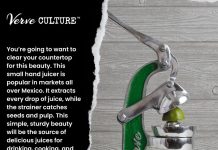Have you ever wondered if it’s possible to extract the refreshing goodness from citrus fruits like oranges and lemons? Well, the answer is a resounding yes! Juicing these zesty fruits not only provides a burst of tangy flavors but also offers a myriad of health benefits. So, if you’re ready to unleash the full potential of these citrus powerhouses, grab your juicer and let’s embark on a juicing adventure that will leave your taste buds tantalized and your body nourished.
Review contents
Benefits of juicing citrus fruits
High in vitamin C
Juicing citrus fruits, such as oranges, lemons, grapefruits, limes, and mandarins, offer a myriad of benefits. One of the most significant benefits of juicing citrus fruits is their high vitamin C content. Vitamin C is an essential nutrient that plays a crucial role in supporting a healthy immune system and promoting overall well-being. By incorporating freshly squeezed citrus juice into our daily routine, we can easily increase our vitamin C intake and give our immune system the boost it needs to fight off illnesses.
Rich in antioxidants
Citrus fruits are also packed with antioxidants, which are beneficial substances that help protect our body from harmful free radicals. These free radicals can damage our cells and contribute to various health issues, including chronic diseases. Antioxidants neutralize these free radicals, reducing the risk of oxidative stress and inflammation. Juicing citrus fruits allows us to enjoy a concentrated dose of these antioxidants, promoting cellular health and reducing the risk of chronic disease.
Boosts digestive health
Thanks to their high fiber content, citrus fruits can improve our digestive health. Fiber aids in proper digestion and prevents constipation by adding bulk to our stools. Juicing citrus fruits allows us to consume the juice without the fiber, making it a great option for individuals with digestive sensitivities or those who simply prefer a fiber-free alternative. By incorporating citrus juice into our diet, we can support a healthy digestive system and ensure regular bowel movements.
Aids in weight loss
If you’re looking to shed a few pounds, juicing citrus fruits can be a valuable addition to your diet. Citrus fruits, particularly lemons and grapefruits, are known for their potential weight loss benefits. These fruits contain compounds that may help boost metabolism and promote fat burning. Additionally, citrus juice can act as a natural appetite suppressant, helping us feel fuller for longer and reducing overall calorie intake. By incorporating citrus juice into a balanced diet and exercise routine, we can enhance our weight loss efforts in a refreshing and delicious way.
Strengthens the immune system
As mentioned earlier, citrus fruits are a fantastic source of vitamin C, which plays a vital role in maintaining a healthy immune system. Our immune system relies on this nutrient to produce white blood cells, which are responsible for fighting off infections and illnesses. By including freshly squeezed citrus juice in our diet, we can help strengthen our immune system, making it more robust and efficient in protecting our overall health.
Types of citrus fruits for juicing
Oranges
Oranges are a popular choice for juicing due to their naturally sweet and refreshing taste. They are also an excellent source of vitamin C, fiber, and other essential nutrients. Whether you prefer juicy navel oranges or tangy Valencia oranges, juicing them will provide a burst of citrus flavor and a nutritious boost.
Lemons
Lemons are incredibly versatile citrus fruits that add a pleasant tanginess to any culinary creation. When juiced, lemons offer a zesty and refreshing flavor profile that can enhance various dishes and beverages. Lemon juice is particularly known for its cleansing and detoxifying properties, making it a popular choice for those looking to rejuvenate their body and maintain a healthy alkaline balance.
Grapefruits
Grapefruits are a great choice for those who prefer a slightly bitter yet invigorating juice. This citrus fruit is low in calories and high in essential vitamins and minerals. The tangy and slightly sour taste of grapefruit juice pairs well with other citrus fruits or can be enjoyed on its own for a refreshing start to the day.
Limes
Limes offer a unique and distinct flavor profile that adds a tangy twist to any drink or dish. Lime juice is commonly used in cocktails and various culinary recipes, as it can enhance the overall taste and aroma. Additionally, limes are rich in vitamin C and provide a refreshing burst of citrus flavor.
Mandarins
Mandarins, also known as tangerines, are small citrus fruits that are easy to peel and full of sweet and juicy segments. They are an excellent choice for juicing, as they provide a burst of citrus flavor with a hint of sweetness. Mandarins are also a great source of vitamin C and other essential nutrients.
Tools needed for citrus fruit juicing
Citrus juicer
A citrus juicer is an essential tool for juicing citrus fruits. It is specially designed to extract the juice from the fruit while keeping the seeds and pulp separate. Citrus juicers come in various designs, including handheld manual juicers and electric juicers. They are easy to use, efficient, and ensure maximum juice extraction.
Hand squeezer
A hand squeezer, also known as a citrus press or citrus reamer, is another tool that can be used to juice citrus fruits. It is a handheld device with a cone-shaped head that helps extract juice when pressure is applied. Hand squeezers are perfect for juicing small quantities of citrus fruits and are easy to clean.
Electric juicer
For those who frequently juice large quantities of citrus fruits, an electric juicer can be a time-saving and convenient option. Electric juicers are motorized machines that automatically extract the juice from the fruits. They are equipped with specialized citrus juicer attachments and can efficiently handle large volumes of citrus juice.
Fine-mesh strainer
While not strictly necessary, a fine-mesh strainer can be used to remove any remaining pulp or seeds from freshly squeezed citrus juice. It ensures a smoother and pulp-free consistency, especially for those who prefer a smoother texture in their juice.
Preparing citrus fruits for juicing
Choosing ripe and juicy fruits
When preparing citrus fruits for juicing, selecting ripe and juicy ones is crucial. Look for fruits that are heavy for their size and have a firm texture. Ripe citrus fruits will also have vibrant colors and give off a sweet and fragrant aroma.
Washing the citrus fruits
Before juicing, it is essential to wash the citrus fruits thoroughly. This step removes any dirt, bacteria, or pesticide residues that may be present on the fruit’s surface. Simply rinse the fruits under cold running water, gently scrubbing them with a brush if necessary.
Rolling the fruits to enhance juicing
To get the most juice out of citrus fruits, rolling them firmly on a countertop before juicing can help break down the fruit’s internal membranes. This makes it easier to extract the juice during the juicing process.
Cutting the fruits into halves
Using a sharp knife, cut the citrus fruits into halves along the equator. This allows you to expose the fruit’s juice-filled segments, making it easier to extract the juice.
Using a citrus juicer or squeezer
Once the citrus fruits are prepared, it’s time to extract the juice. Depending on the juicing method you prefer, use a citrus juicer or a hand squeezer to squeeze the fruits and extract their juice. Ensure the citrus juicer’s cone or the hand squeezer’s head is firmly pressed against the fruit’s cut side to maximize juice extraction.
Methods of juicing citrus fruits
Manual squeezing
Manual squeezing is one of the most common and straightforward methods of juicing citrus fruits. All you need is a citrus juicer or a hand squeezer to extract the juice. This method allows you to control the amount of pressure applied, resulting in a customized and freshly squeezed citrus juice.
Using an electric juicer
For larger quantities of citrus juice, an electric juicer can be a time-saving option. Electric juicers automatically extract the juice from the fruits with minimal effort. Simply place the citrus halves on the juicer’s cone, and the machine will do the rest. Electric juicers ensure fast and efficient juice extraction, perfect for those who juice regularly or in larger batches.
Hand-pressing the fruits
Hand-pressing is a convenient method that requires minimal tools. To hand-press citrus fruits, place the cut side of the fruit on a flat surface and use your hand or a utensil to apply pressure and squeeze out the juice. While this method may not produce as much juice as a dedicated juicer, it can still be an effective way to extract juice when juicing small quantities.
Blending the fruits
Another method of juicing citrus fruits is by blending them. Simply peel and section the citrus fruits, removing any seeds, and place them in a blender. Blend until smooth, and then strain the mixture through a fine-mesh strainer to separate the pulp and seeds. Blending the fruits creates a thicker and more textured juice, perfect for smoothies or blended beverages.
Straining the pulp and seeds
Regardless of the juicing method used, straining the freshly squeezed citrus juice can help remove any remaining pulp and seeds. A fine-mesh strainer or a cheesecloth can be used to achieve a smoother and pulp-free consistency, depending on personal preferences.
Different citrus juice variations
Pure citrus juice
Pure citrus juice refers to the juice extracted solely from a single citrus fruit, such as oranges or lemons. Pure citrus juice allows the natural flavor and characteristics of the fruit to shine through, providing a refreshing and tangy taste experience.
Citrus juice blends
Citrus juice blends combine the flavors of different citrus fruits to create a unique and well-balanced taste. Blending fruits like oranges, lemons, limes, and grapefruits can result in a delightful combination of sweet, tangy, and slightly bitter flavors. Citrus juice blends offer a refreshing and complex taste profile that can be enjoyed on its own or used as a base for cocktails and mocktails.
Citrus cocktails
Citrus fruits are a staple ingredient in many refreshing and vibrant cocktails. From classic margaritas to tangy mojitos, citrus juice adds a burst of flavor and balances the sweetness of other ingredients. Whether shaken or stirred, citrus cocktails are perfect for social gatherings or simply enjoying a delightful drink after a long day.
Citrus-infused water
Infusing water with citrus fruits is a simple and refreshing way to enjoy a hint of citrus flavor without the added sugar or calories. Sliced citrus fruits can be added to a pitcher of water, allowing the flavors to infuse and create a naturally flavored and hydrating beverage. Citrus-infused water is a healthy and flavorful alternative to sugary sodas or fruit juices.
Citrus smoothies
Citrus fruits can also be incorporated into vibrant and nutritious smoothies. Simply blend citrus juice with other fruits, vegetables, and a liquid base such as yogurt or almond milk to create a delicious and nutrient-packed beverage. Citrus smoothies are a great option for a quick and energizing breakfast or a refreshing post-workout snack.
Storing and preserving citrus juice
Refrigeration
The easiest and most common way to store freshly squeezed citrus juice is by refrigerating it. Transfer the juice into a clean, airtight container and place it in the refrigerator. Properly refrigerated citrus juice can stay fresh for up to 2-3 days, allowing you to enjoy its goodness over time.
Freezing
To preserve citrus juice for an extended period, freezing is a viable option. Pour the freshly squeezed juice into ice cube trays or freezer-safe containers, leaving some headspace for expansion. Once frozen, transfer the citrus juice cubes or containers to a Ziploc bag or an airtight container to prevent freezer burn. Frozen citrus juice can last for up to 3 months, providing a convenient and concentrated citrus flavor whenever needed.
Using airtight containers
Using airtight containers is crucial for storing citrus juice to maintain its freshness and prevent contamination. Glass jars or BPA-free plastic containers with tight-fitting lids are suitable for storing citrus juice in the refrigerator or freezer.
Adding lemon or lime juice as preservatives
To extend the shelf life of freshly squeezed citrus juice, adding a small amount of lemon or lime juice can act as a natural preservative. The high acidity of lemon and lime juice helps inhibit bacterial growth and slow down the oxidation process. Simply add a teaspoon of lemon or lime juice per cup of citrus juice and mix well before refrigerating or freezing.
Canning
For those who enjoy the art of canning, citrus juice can be preserved in jars using the proper canning techniques. Canned citrus juice can last for several months or even up to a year when stored in a cool, dark place. This method ensures that you have a supply of fresh citrus juice readily available regardless of the season.
Additional uses for citrus peels
Zesting for cooking and baking
Citrus peels can provide a burst of flavor when zested and added to various culinary creations. The zest contains the aromatic oils of the fruit, lending a bright and tangy flavor to dishes like salads, marinades, baked goods, and desserts. Grate the peels using a fine grater or a microplane for a quick and easy way to incorporate citrus flavor into your recipes.
Making infused oils and vinegars
Citrus peels can be used to infuse oils and vinegars, adding a unique and vibrant flavor profile. Simply place strips of citrus peel into a bottle of olive oil or vinegar and allow the flavors to infuse over time. The resulting infused oils and vinegars can be used in dressings, marinades, or as a finishing touch to various dishes.
Natural cleaning solutions
Citrus peels can be used to create natural and effective cleaning solutions for various household chores. The acidity and citrus oils in the peels make them excellent for cutting through grease, removing stains, and deodorizing surfaces. For example, rubbing a lemon peel on cutting boards or countertops can help eliminate strong odors and sanitize the surfaces.
DIY citrus-scented candles
Create your own aromatic and eco-friendly candles by incorporating citrus peels. Infuse melted candle wax with grated citrus peels and pour the mixture into candle molds or repurposed containers. As the candles burn, they will release a refreshing and uplifting citrus scent, creating a pleasant atmosphere in your home.
Citrus potpourri
Dried citrus peels can be used to make fragrant and natural potpourri. Collect and dry citrus peels by placing them in a well-ventilated area until they become completely dry and brittle. Combine the dried peels with other aromatic ingredients like spices, dried flowers, or herbs to create a customized potpourri blend. Display the potpourri in bowls or sachets to add a fresh and invigorating scent to any room.
Recipes incorporating citrus juice
Citrus vinaigrette
Ingredients:
- 1/4 cup freshly squeezed citrus juice (lemon, lime, or orange)
- 1/4 cup extra virgin olive oil
- 1 tablespoon honey or maple syrup
- 1 teaspoon Dijon mustard
- Salt and pepper to taste
Instructions:
- In a small bowl, whisk together the citrus juice, olive oil, honey or maple syrup, Dijon mustard, salt, and pepper until well combined.
- Taste and adjust the seasonings according to your preference.
- Drizzle the citrus vinaigrette over salads, grilled vegetables, or roasted chicken for a refreshing burst of flavor.
Lemonade
Ingredients:
- 4-6 lemons, juiced
- 4 cups water
- 1/2 cup granulated sugar, or to taste
- Ice cubes and lemon slices for serving
Instructions:
- In a pitcher, combine the freshly squeezed lemon juice, water, and granulated sugar.
- Stir well until the sugar is dissolved.
- Taste the lemonade and adjust the sweetness and tartness by adding more sugar or lemon juice if desired.
- Serve the lemonade over ice cubes and garnish with lemon slices for a thirst-quenching and tangy beverage.
Orange chicken
Ingredients:
- 4 boneless, skinless chicken breasts, cut into bite-sized pieces
- 1/2 cup freshly squeezed orange juice
- 1/4 cup soy sauce
- 2 tablespoons honey
- 2 tablespoons cornstarch
- 2 cloves garlic, minced
- 1 teaspoon grated fresh ginger
- Vegetable oil for frying
Instructions:
- In a bowl, whisk together the orange juice, soy sauce, honey, cornstarch, minced garlic, and grated ginger until well combined. Set aside.
- Heat vegetable oil in a large skillet or wok over medium-high heat.
- Add the chicken pieces and cook until browned and cooked through.
- Pour the orange sauce mixture over the chicken and stir well to coat.
- Continue cooking for a few minutes until the sauce thickens and coats the chicken.
- Serve the orange chicken with steamed rice or noodles for a delicious and tangy meal.
Lemon bars
Ingredients:
- For the crust:
- 2 cups all-purpose flour
- 1/2 cup powdered sugar
- 1 cup unsalted butter, cold and diced
- For the filling:
- 4 large eggs
- 2 cups granulated sugar
- 1/3 cup freshly squeezed lemon juice
- Zest of 2 lemons
- 1/4 cup all-purpose flour
- Powdered sugar for dusting
Instructions:
- Preheat the oven to 350°F (175°C) and line a 9×13-inch baking dish with parchment paper.
- In a large bowl, combine the flour and powdered sugar for the crust. Cut in the cold diced butter using a pastry cutter or your fingers until the mixture resembles coarse crumbs.
- Press the crust mixture evenly into the prepared baking dish, creating a firm and even layer.
- Bake the crust for 20 minutes until lightly golden. Remove from the oven and set aside.
- Meanwhile, in another bowl, whisk together the eggs, granulated sugar, lemon juice, lemon zest, and flour for the filling until well combined.
- Pour the filling mixture over the baked crust and return the baking dish to the oven.
- Bake for an additional 25-30 minutes until the filling is set and the edges are lightly golden.
- Remove from the oven and let cool completely before cutting into squares.
- Dust the lemon bars with powdered sugar before serving for a delectable and tangy treat.
Grapefruit granita
Ingredients:
- 2 cups freshly squeezed grapefruit juice
- 1/2 cup granulated sugar
- 1 tablespoon freshly squeezed lemon juice
Instructions:
- In a saucepan, combine the grapefruit juice, granulated sugar, and lemon juice over medium heat.
- Stir until the sugar is dissolved and the mixture is well combined.
- Pour the mixture into a shallow dish or baking pan and place it in the freezer.
- After 30 minutes, use a fork to scrape and mix the semi-frozen mixture.
- Repeat this process every 30 minutes for about 3-4 hours, or until the granita has a slushy and icy texture.
- Serve the grapefruit granita in chilled glasses for a refreshing and tangy frozen dessert.
Potential health risks and precautions
Citrus allergies
While citrus fruits are generally safe for consumption, some individuals may have allergies or sensitivities to them. Citrus allergies can range from mild to severe and may cause symptoms such as itching, rashes, swelling, or difficulty breathing. If you suspect you have a citrus allergy, it is essential to consult a healthcare professional for proper diagnosis and guidance.
Tooth enamel erosion
Citrus fruits, particularly their juice, contain natural acids that can erode tooth enamel over time. The acid can soften the enamel, making it more susceptible to erosion and tooth decay. To minimize the risk of tooth enamel erosion, it is recommended to consume citrus juice in moderation, drink plenty of water to rinse the mouth, and wait at least 30 minutes before brushing your teeth after consuming citrus juice.
Heartburn or acid reflux
For individuals with gastroesophageal reflux disease (GERD) or frequent heartburn, consuming citrus juice may worsen their symptoms. The high acidity in citrus fruits can irritate the esophagus and trigger acid reflux. It is advisable to monitor your response to consuming citrus juice and consult a healthcare professional if you experience any discomfort.
Interference with certain medications
Citrus fruits, particularly grapefruits, can interact with specific medications and affect their effectiveness or cause adverse side effects. These interactions occur due to compounds in citrus fruits that interfere with enzymes responsible for metabolizing medications. If you are taking prescription medications, it is essential to consult your healthcare provider to determine if there are any potential interactions with citrus fruits.
Sensitive skin reactions
Direct contact with citrus juice or peels may cause skin irritation or allergic reactions in some individuals. Those with sensitive skin should exercise caution when handling or juicing citrus fruits. To minimize the risk of skin reactions, it is advisable to wear gloves or wash hands thoroughly after juicing or handling citrus fruits.
In conclusion, juicing citrus fruits offers numerous benefits, including a high vitamin C content, antioxidant-rich properties, digestive health support, weight loss assistance, and immune system strengthening. Various citrus fruits, such as oranges, lemons, grapefruits, limes, and mandarins, can be juiced to create refreshing and flavorful beverages. Tools such as citrus juicers, hand squeezers, electric juicers, and fine-mesh strainers are commonly used for citrus fruit juicing. Preparing citrus fruits involves choosing ripe and juicy fruits, washing them, rolling them for enhanced juicing, cutting them into halves, and using a citrus juicer or squeezer to extract the juice. Different methods of juicing include manual squeezing, using an electric juicer, hand-pressing the fruits, blending the fruits, and straining the pulp and seeds. Citrus juice can be enjoyed in its pure form, blended with other fruits, incorporated into cocktails, infused in water, or added to smoothies. Proper storage and preservation of citrus juice can be achieved through refrigeration, freezing, using airtight containers, adding lemon or lime juice as preservatives, or canning. Additionally, citrus peels can be utilized for zesting, making infused oils, natural cleaning solutions, DIY citrus-scented candles, or citrus potpourri. Recipes such as citrus vinaigrette, lemonade, orange chicken, lemon bars, and grapefruit granita allow for creative and delicious ways to incorporate citrus juice. However, it is essential to be aware of potential health risks and precautions, including citrus allergies, tooth enamel erosion, heartburn or acid reflux, interference with certain medications, and sensitive skin reactions. By considering these factors, we can fully enjoy the benefits of juicing citrus fruits while maintaining our health and well-being.

































